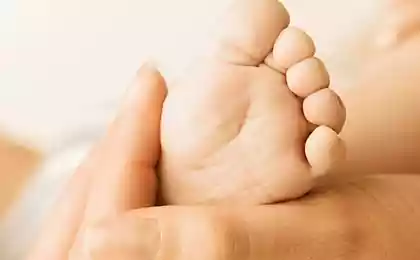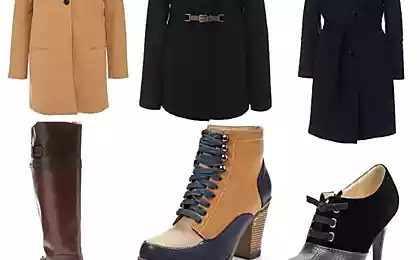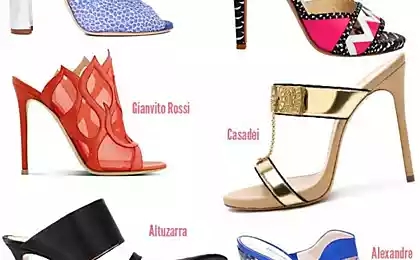692
How to fix flat feet and club foot in children
How to fix a club foot
Not to be confused with "club foot" (cast of foot) and clubfoot. They have a lot in common, but different degrees of neglect.
It is advisable to do so before the age of 6, "playfully", i.e. without consciousness of the child. Later they will have to find convincing arguments to explain the need to do certain exercises to go to one and not the other section, to wear such and not other shoes.
The main task – to develop in children the habit of moving. For this you need to stimulate those muscles, which will help to rectify injured (not properly formed) joints.
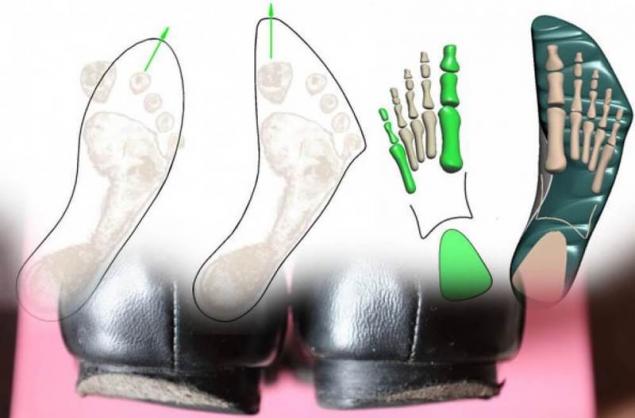
Here are some of the exercises that will help your child solve this problem:
1. Squats with heavy (printed) with the ball in his hands in front. To execute it, the child will be forced to raise the knees and feet. Back straight and bend at the waist. Very boring exercise for children.
Better.
2. Raising the ball off the floor and throw friend, dad, mom, ring, box, etc.
3. "Bowling", only to throw the balls as in exercise 2.
4. Jumping on the ball with "ears" (between the legs).
5. Riding on horseback. The accent on the heels. They should rest against the horse's flanks so that it was convenient "spur".
6. Tumbling over your head forward/backward. The knees are placed so that they fit the child's head, not his knees hit me in the teeth. I warn you, a very difficult exercise for the feet and X-shaped knees. This is likely to be your test about the presence of positive trends when correcting. To encourage development of this skill is necessary.
7. Jumping on a car tire. Its size depends on the age. Move body forward until the opposite side of the tire, then back. The legs then diverge to the sides, then come together.
8. Walking "Christmas tree" on the Board, the Board, as do gymnasts on the balance beam.
9. To go down the "tree" on the escalator, moving up. Very emotional and effective exercise!
10. Spin on "the stool of the pianist". Push off one foot and throw the other in the side with its foot and knee. Like a side step, just sitting on a swivel chair. Spinning in different directions. Very useful also for the vestibular apparatus.
11. "Go in the closet." Importantly, the space between the two walls was narrow at the place of stop. Its width should be less than the length of the foot to stimulate her abduction.
12. Crawling on their bellies under Cabinet, bench etc. the abdomen and pelvis should not break away from the floor. At first it will be difficult.
13. Riding a mountain on a sled, lying on his stomach, feet are divorced and do not relate to snow.
14. Stand on the outside of the foot rolling. One foot is on the outside, the other is as usual. Transfer weight from one foot to the other, changing the position of the feet. Develop the ankle, formed by the outer arch, train the sequence of interaction of the muscles.
15. Football. One strikes the ball only "cheek".
16. Climbing.
17. Choreography.
18. Swimming "breaststroke" frog.
This, of course, not all exercises, and basic, which I tested on myself, friends and other people's children.
I hope You noticed that most of the exercises seek to bring the child in a pose of "frog".
Remember her newborn baby in the first days of life. Whenever, as soon as it was freed from the cradle, his legs pulled up and flew to the side. And, my knees touched the sheets, especially when he fell asleep. The same foot position was, when the baby lying on her belly, raised her head and flexes the back.
Our swaddle, wrap, etc. was getradiovalue joints and rear outer muscles. The result is a club foot, flat feet, etc. Now have to do the opposite.
Just, please, don't wear the left Shoe on the right foot, and the right to the left, as some doctors suggest. Except for the negative, the other will have no effect. Who does not believe, try to change your shoes in some places.... And what?
The genius of this Council that you need to do exactly the opposite, to the officially accepted method of treatment of a cast of the feet. That's what I suggest You to use it.
"The best teacher wall. On nastakisi not, you still hit". If you fail to equip your flat, play area, garden, cottage, etc. need cabinets, walls, and arouse interest in children to play "Your game", then the year after 2 – 3 forget about the foot and the poor posture, and along on flat feet. Will just have to watch that habit of moving, not podmenili fashionable "WikiName" transition periods.
How to fix flat feet
Exercises to correct flat feet, practically the same. The only some adjustments need to be made in terms of restricting the maximum amplitudes in the presence of a large "play" in the joints of the navicular bone (at least — at the base of the first metatarsal). Visually, the inner surface of the foot will have an angle directed to the opposite stop (" ").
In other words, do not try to put the baby in the extreme (classical) position of the choreography, while these joints do not get stronger. At the beginning of "train" heel to be vertical, and the foot doesn't "feel" comfortable on the outside. Initially it is necessary to properly shape the outer arch of the foot. He is the guarantor of the proper formation of others.
Flat feet and club foot today one of the most common defects are closely interrelated. Flat feet without a cast stop can be found, a cast without plantar fasciitis is the exception rather than the rule. Itself cast, contributes to the blockage of the heel. This is an indication of flat feet.
And yet, one very, very important detail. You must choose the right shoes, and then by her rework.
Exercise, of course, a huge stimulant for the proper formation of the foot, but how much would you have them do, the number of repetitions is a drop in the bucket compared to the number of steps in the "wrong" shoes that our kids are doing during the day.
Judge for yourself. Normative range of motion for the pedometer for daily stay in preschool institution (always in sandals!):
For comparison, we do about 5,000 at the rate of 10,000 movements per day.
The output is:
1. Useful to organize games.
2. Shoes in the "right" shoes.
How to modify shoes
Try to find shoes with a solid sole or low heels. The problem is not so much the presence of a heel (even a "stud" can be useful), but in its form and placement, and most importantly, in the absence of support under the base of the 5th metatarsal, which plays a dominant role in the formation of the arches of the foot (the bone on the external side of the foot, approximately in the middle). The soles should be wide. The less she appears beyond the upper, especially the heel, the better.
Here's an example for the most common form of the sole.
(see drawing and photo)
1. Cut the heel at an angle 5-10. Remove constructive the blockage of shoes.
2. Determine the angle of cut (ASR) and make a slice from the bottom to the top or near the top edge of the sole (depending on its design). Helps the muscles to withdraw the foot.
3. Round the outer side of the front part of the sole and the remaining part of the heel. For smooth rolling and forming the outer arch of the foot.
4. Stick the insert under the heel (from the middle at an angle of 25-30). For forming the inner and transverse arches by twisting of the forefoot relative to the rear.
5. Stick the insert under the metatarsal heads 2-4 (under grounds 2-4 toes). For the formation of the transverse arch and training of the thumb. Please note: for the feet top horizontal, and reserved for flat – convex. The thickness of the insert 3-5mm, depending on the age and degree of flattening of the foot.


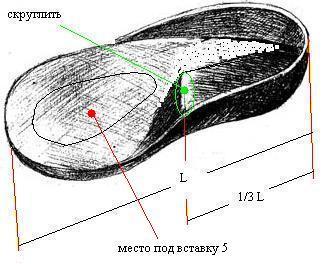

width insert number 5 in Fig.not perfect, but sufficient for the formation of the transverse arch with hand finishing.


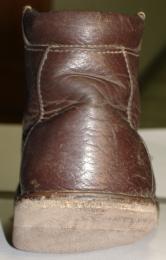

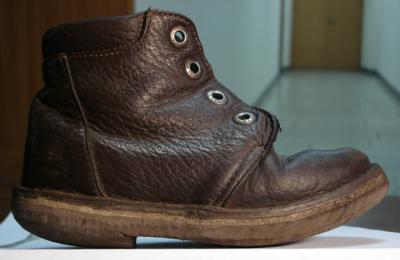

In photos: the actual heel bone in the back and one of my first modifications for the prevention and treatment of flatfoot. The earlier method improvements more effective. But this also works well. Pay attention to the heel. The cut is made from the middle. The heel back is very similar to the calcaneus of the foot (see photo). Approximately the same angles. From the side it is noticeable that the heel is rounded and quite significantly. Refinement was carried out with a knife Shoe. Visible notches on the side of the soles. On the heel they were about the same. Now, almost perfectly polished surface. This speaks to how loaded, the work plan, this element of the foot. So, from how we ship it (under what angles, etc.) depends on the formation of the foot.
I specifically show these photos in order to not upset the aesthetic appearance. No one will pay attention to it. Fundamentally important FORMS. We are so loaded with mythical problems-ending quest for the "carrot" (as the donkey, the nose of which it hangs), that do not see their own children.
Remember, please. As worn-out shoes from child, wife, husband, father, mother? When was the last time you looked at your boot?
Now, what can you say about the upper part of the Shoe girlfriend, friend? Sure, in this case, we will be more verbose.
Believe me, the child not interested (at least up to 6 years) fashion, wear what you they are well presented. Harder more. It is very difficult psychologically to "spoil" the new thing bought with own money! Especially when someone, and be sure to find, close to regular releases in your address phrase: "are Nonsense, you'd better have a ...", "All go and nothing", "still nothing", etc.
Personally, I acquired "immunity" to such remarks, only three years later. You will have to choose. Either you "mess up" shoes, or it will cripple your children's feet! There is, however, another way is to organize the production of physiological footwear (not to be confused with orthopedic). In my opinion, the most reasonable solution. But not all the strength.
The rescue of drowning — the handiwork of drowning! Shoes Refine, develop physiological movements and you will see great results. Many models of shoes, of course, will not allow to implement all my recommendations. Shoes just fall apart. Do it at least. Will still work!
The angles on the drawing are mostly maximum. Depending on the shoes and the defect can be reduced, but not more than half.
A little bit about the toe of the Shoe
I will not paint any physical problems arising due to the mobility limitations of our toes. I will say one thing. Related and sealed in the narrow space of the Shoe, they contribute to the formation of defects of the foot, instead of his direct purpose is to stimulate its proper development.






Great! Almost perfect shape-top shoes.
Also interesting: Flatfoot is not a harmless disease!
If the child walks on tiptoe
Please note for children's gym shoes. Just lovely! It remains only to remove the seam from the outside and just change the heels. But even so, they're much better than modern sandals and cheshek. And quite possibly, will help to correct a club foot and flat feet in children. It is theoretically possible. The main thing is to identify the root cause of the defect. Then it will be easier to pick up a set of measures for correction.published
The author: Alexander Kiselev
Source: www.kramola.info/vesti/protivostojanie/kak-ispravit-ploskostopie-i-kosolapie-aleksandr-kiselyov
Not to be confused with "club foot" (cast of foot) and clubfoot. They have a lot in common, but different degrees of neglect.
It is advisable to do so before the age of 6, "playfully", i.e. without consciousness of the child. Later they will have to find convincing arguments to explain the need to do certain exercises to go to one and not the other section, to wear such and not other shoes.
The main task – to develop in children the habit of moving. For this you need to stimulate those muscles, which will help to rectify injured (not properly formed) joints.

Here are some of the exercises that will help your child solve this problem:
1. Squats with heavy (printed) with the ball in his hands in front. To execute it, the child will be forced to raise the knees and feet. Back straight and bend at the waist. Very boring exercise for children.
Better.
2. Raising the ball off the floor and throw friend, dad, mom, ring, box, etc.
3. "Bowling", only to throw the balls as in exercise 2.
4. Jumping on the ball with "ears" (between the legs).
5. Riding on horseback. The accent on the heels. They should rest against the horse's flanks so that it was convenient "spur".
6. Tumbling over your head forward/backward. The knees are placed so that they fit the child's head, not his knees hit me in the teeth. I warn you, a very difficult exercise for the feet and X-shaped knees. This is likely to be your test about the presence of positive trends when correcting. To encourage development of this skill is necessary.
7. Jumping on a car tire. Its size depends on the age. Move body forward until the opposite side of the tire, then back. The legs then diverge to the sides, then come together.
8. Walking "Christmas tree" on the Board, the Board, as do gymnasts on the balance beam.
9. To go down the "tree" on the escalator, moving up. Very emotional and effective exercise!
10. Spin on "the stool of the pianist". Push off one foot and throw the other in the side with its foot and knee. Like a side step, just sitting on a swivel chair. Spinning in different directions. Very useful also for the vestibular apparatus.
11. "Go in the closet." Importantly, the space between the two walls was narrow at the place of stop. Its width should be less than the length of the foot to stimulate her abduction.
12. Crawling on their bellies under Cabinet, bench etc. the abdomen and pelvis should not break away from the floor. At first it will be difficult.
13. Riding a mountain on a sled, lying on his stomach, feet are divorced and do not relate to snow.
14. Stand on the outside of the foot rolling. One foot is on the outside, the other is as usual. Transfer weight from one foot to the other, changing the position of the feet. Develop the ankle, formed by the outer arch, train the sequence of interaction of the muscles.
15. Football. One strikes the ball only "cheek".
16. Climbing.
17. Choreography.
18. Swimming "breaststroke" frog.
This, of course, not all exercises, and basic, which I tested on myself, friends and other people's children.
I hope You noticed that most of the exercises seek to bring the child in a pose of "frog".
Remember her newborn baby in the first days of life. Whenever, as soon as it was freed from the cradle, his legs pulled up and flew to the side. And, my knees touched the sheets, especially when he fell asleep. The same foot position was, when the baby lying on her belly, raised her head and flexes the back.
Our swaddle, wrap, etc. was getradiovalue joints and rear outer muscles. The result is a club foot, flat feet, etc. Now have to do the opposite.
Just, please, don't wear the left Shoe on the right foot, and the right to the left, as some doctors suggest. Except for the negative, the other will have no effect. Who does not believe, try to change your shoes in some places.... And what?
The genius of this Council that you need to do exactly the opposite, to the officially accepted method of treatment of a cast of the feet. That's what I suggest You to use it.
"The best teacher wall. On nastakisi not, you still hit". If you fail to equip your flat, play area, garden, cottage, etc. need cabinets, walls, and arouse interest in children to play "Your game", then the year after 2 – 3 forget about the foot and the poor posture, and along on flat feet. Will just have to watch that habit of moving, not podmenili fashionable "WikiName" transition periods.
How to fix flat feet
Exercises to correct flat feet, practically the same. The only some adjustments need to be made in terms of restricting the maximum amplitudes in the presence of a large "play" in the joints of the navicular bone (at least — at the base of the first metatarsal). Visually, the inner surface of the foot will have an angle directed to the opposite stop (" ").
In other words, do not try to put the baby in the extreme (classical) position of the choreography, while these joints do not get stronger. At the beginning of "train" heel to be vertical, and the foot doesn't "feel" comfortable on the outside. Initially it is necessary to properly shape the outer arch of the foot. He is the guarantor of the proper formation of others.
Flat feet and club foot today one of the most common defects are closely interrelated. Flat feet without a cast stop can be found, a cast without plantar fasciitis is the exception rather than the rule. Itself cast, contributes to the blockage of the heel. This is an indication of flat feet.
And yet, one very, very important detail. You must choose the right shoes, and then by her rework.
Exercise, of course, a huge stimulant for the proper formation of the foot, but how much would you have them do, the number of repetitions is a drop in the bucket compared to the number of steps in the "wrong" shoes that our kids are doing during the day.
Judge for yourself. Normative range of motion for the pedometer for daily stay in preschool institution (always in sandals!):
- 3 years: 9 000 – 9 500 movements
- 4 years: 10 000 – 10 500 movements
- 5 years: 11 000 – 12 000 movements
- 6 years: 13 000 – 13 500 movements
- 7 years: 14 000 – 15 000 movements
For comparison, we do about 5,000 at the rate of 10,000 movements per day.
The output is:
1. Useful to organize games.
2. Shoes in the "right" shoes.
How to modify shoes
Try to find shoes with a solid sole or low heels. The problem is not so much the presence of a heel (even a "stud" can be useful), but in its form and placement, and most importantly, in the absence of support under the base of the 5th metatarsal, which plays a dominant role in the formation of the arches of the foot (the bone on the external side of the foot, approximately in the middle). The soles should be wide. The less she appears beyond the upper, especially the heel, the better.
Here's an example for the most common form of the sole.
(see drawing and photo)
1. Cut the heel at an angle 5-10. Remove constructive the blockage of shoes.
2. Determine the angle of cut (ASR) and make a slice from the bottom to the top or near the top edge of the sole (depending on its design). Helps the muscles to withdraw the foot.
3. Round the outer side of the front part of the sole and the remaining part of the heel. For smooth rolling and forming the outer arch of the foot.
4. Stick the insert under the heel (from the middle at an angle of 25-30). For forming the inner and transverse arches by twisting of the forefoot relative to the rear.
5. Stick the insert under the metatarsal heads 2-4 (under grounds 2-4 toes). For the formation of the transverse arch and training of the thumb. Please note: for the feet top horizontal, and reserved for flat – convex. The thickness of the insert 3-5mm, depending on the age and degree of flattening of the foot.




width insert number 5 in Fig.not perfect, but sufficient for the formation of the transverse arch with hand finishing.






In photos: the actual heel bone in the back and one of my first modifications for the prevention and treatment of flatfoot. The earlier method improvements more effective. But this also works well. Pay attention to the heel. The cut is made from the middle. The heel back is very similar to the calcaneus of the foot (see photo). Approximately the same angles. From the side it is noticeable that the heel is rounded and quite significantly. Refinement was carried out with a knife Shoe. Visible notches on the side of the soles. On the heel they were about the same. Now, almost perfectly polished surface. This speaks to how loaded, the work plan, this element of the foot. So, from how we ship it (under what angles, etc.) depends on the formation of the foot.
I specifically show these photos in order to not upset the aesthetic appearance. No one will pay attention to it. Fundamentally important FORMS. We are so loaded with mythical problems-ending quest for the "carrot" (as the donkey, the nose of which it hangs), that do not see their own children.
Remember, please. As worn-out shoes from child, wife, husband, father, mother? When was the last time you looked at your boot?
Now, what can you say about the upper part of the Shoe girlfriend, friend? Sure, in this case, we will be more verbose.
Believe me, the child not interested (at least up to 6 years) fashion, wear what you they are well presented. Harder more. It is very difficult psychologically to "spoil" the new thing bought with own money! Especially when someone, and be sure to find, close to regular releases in your address phrase: "are Nonsense, you'd better have a ...", "All go and nothing", "still nothing", etc.
Personally, I acquired "immunity" to such remarks, only three years later. You will have to choose. Either you "mess up" shoes, or it will cripple your children's feet! There is, however, another way is to organize the production of physiological footwear (not to be confused with orthopedic). In my opinion, the most reasonable solution. But not all the strength.
The rescue of drowning — the handiwork of drowning! Shoes Refine, develop physiological movements and you will see great results. Many models of shoes, of course, will not allow to implement all my recommendations. Shoes just fall apart. Do it at least. Will still work!
The angles on the drawing are mostly maximum. Depending on the shoes and the defect can be reduced, but not more than half.
A little bit about the toe of the Shoe
I will not paint any physical problems arising due to the mobility limitations of our toes. I will say one thing. Related and sealed in the narrow space of the Shoe, they contribute to the formation of defects of the foot, instead of his direct purpose is to stimulate its proper development.






Great! Almost perfect shape-top shoes.
Also interesting: Flatfoot is not a harmless disease!
If the child walks on tiptoe
Please note for children's gym shoes. Just lovely! It remains only to remove the seam from the outside and just change the heels. But even so, they're much better than modern sandals and cheshek. And quite possibly, will help to correct a club foot and flat feet in children. It is theoretically possible. The main thing is to identify the root cause of the defect. Then it will be easier to pick up a set of measures for correction.published
The author: Alexander Kiselev
Source: www.kramola.info/vesti/protivostojanie/kak-ispravit-ploskostopie-i-kosolapie-aleksandr-kiselyov
A former top Manager of Volvo will create an electric car in China
Rules of life from Russian writers




